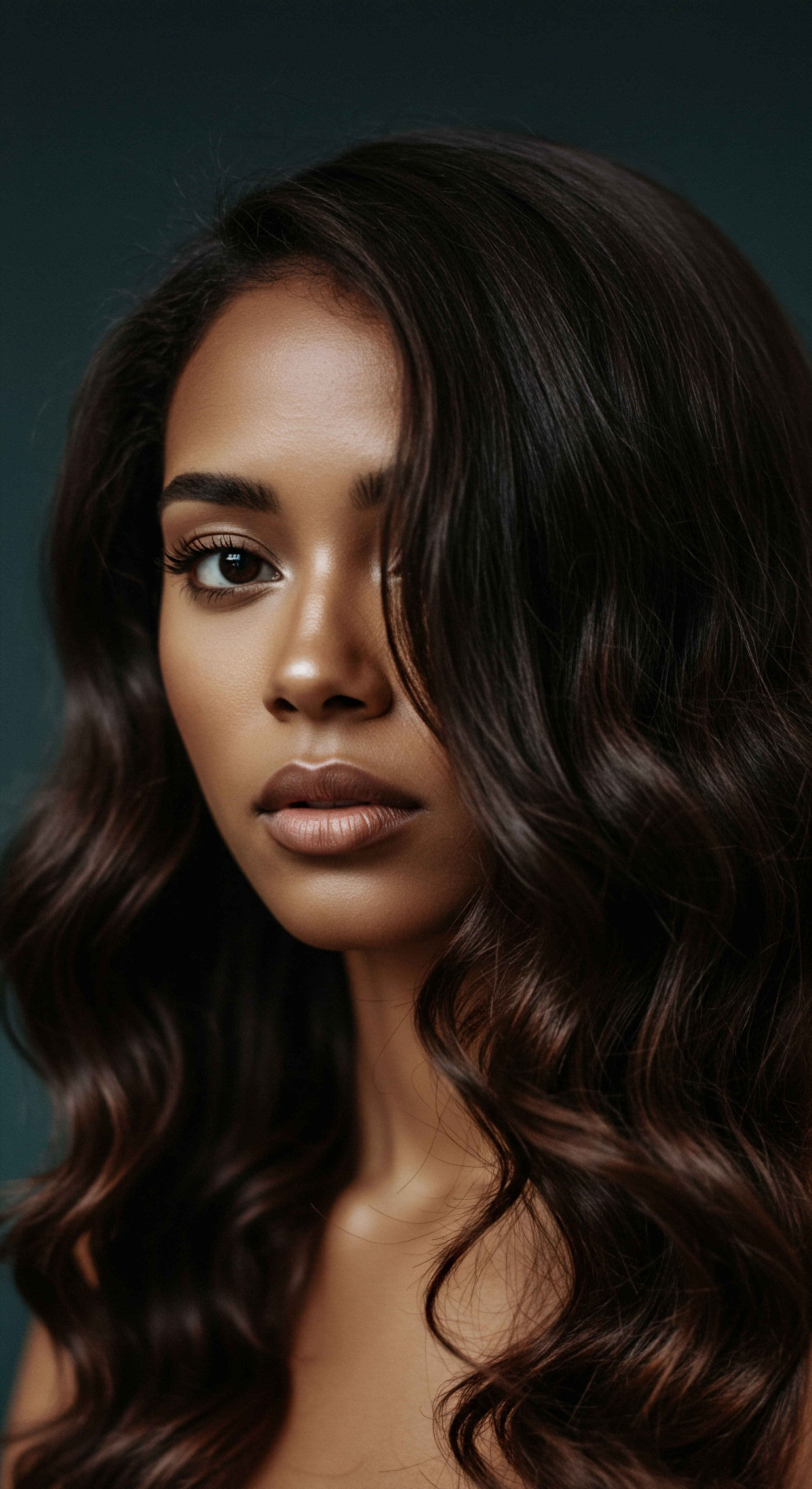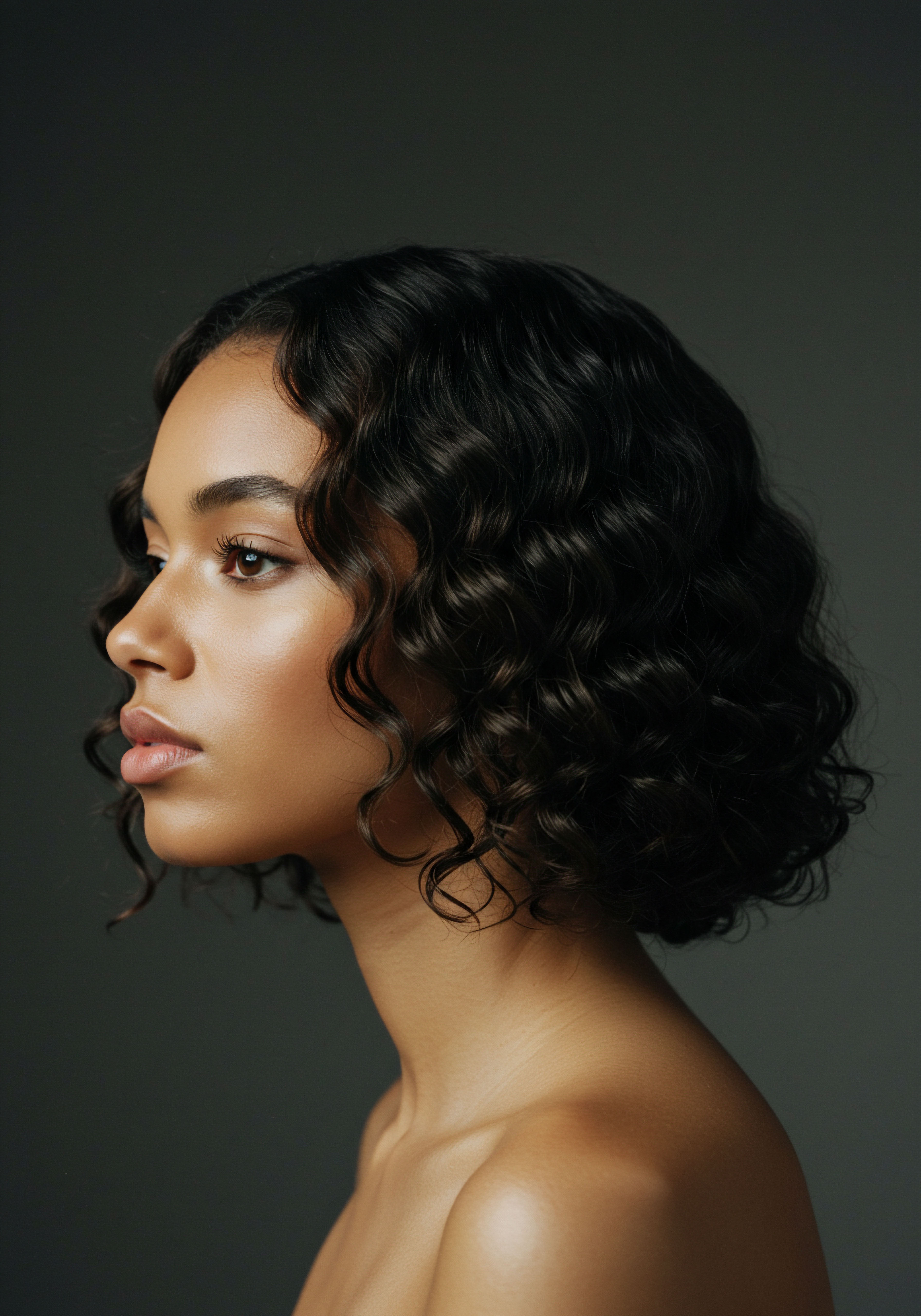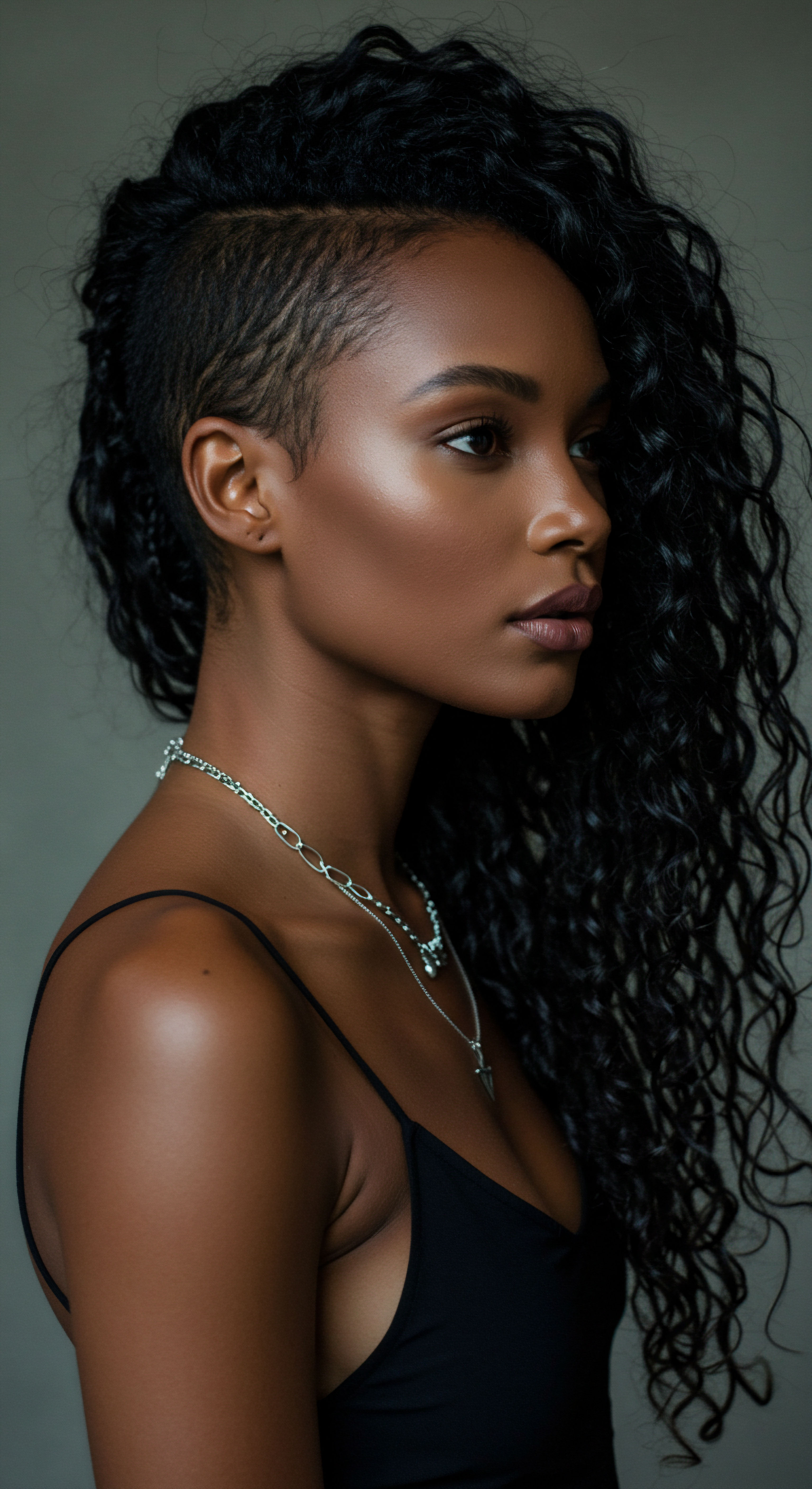
Roots
The quiet rustle of leaves at dusk, the gentle murmur of a stream, or the profound stillness of a starlit night — these are the subtle rhythms of our world. So too, within the intimate landscape of our textured strands, exist delicate dynamics that shape their vitality. For those with hair that coils, curls, or crimps, understanding the fundamental architecture of each strand becomes a foundational pursuit. This is where we begin our exploration, not with a fleeting trend, but with the very building blocks that dictate a hair’s journey through time.
Consider the individual hair fiber, a marvel of biological engineering. At its exterior, the cuticle stands as a protective shield, a series of overlapping scales, much like shingles on a roof. These scales, made of keratinocytes, are meant to lie flat, creating a smooth surface that reflects light and seals moisture within.
However, textured hair, with its inherent twists and turns, possesses a cuticle that is often naturally lifted at various points along the fiber, particularly pronounced in the more elliptical cross-sections common among individuals of African ancestry. This configuration, while beautiful, renders textured hair inherently more susceptible to mechanical wear and tear than straighter hair types.
This increased vulnerability stems from the very structure. When these lifted cuticle scales encounter friction, they can snag, chip, or lift further, leading to damage. Over time, this cumulative abrasion can compromise the hair’s integrity, diminishing its ability to retain moisture and resist breakage. The challenge, then, lies in mitigating these daily interactions that, while seemingly minor, accumulate into significant long-term consequences for hair health.
Understanding the inherent structure of textured hair, particularly its delicate cuticle, reveals why protective measures are so vital.

Hair Fiber’s Delicate Exterior
The outermost layer, the cuticle, serves as the primary defense against external stressors. Its integrity is paramount for hair strength and moisture retention. When the cuticle is smooth and sealed, it creates a formidable barrier. Yet, the very geometry of textured hair means these protective scales are not always uniformly flat.
The natural undulations and bends present points of vulnerability, areas where the cuticle is predisposed to lifting. This structural characteristic makes hair more prone to damage from routine activities.
Every brush stroke, every shift on a pillow, every interaction with clothing can contribute to micro-abrasions. These seemingly insignificant moments collectively chip away at the cuticle’s protective barrier. As the cuticle degrades, the hair becomes rougher, duller, and more susceptible to moisture loss, setting the stage for increased fragility and eventual breakage.
- Cuticle Integrity ❉ The outermost layer of hair, responsible for protection and shine, is easily compromised by friction.
- Mechanical Stress ❉ Daily grooming and environmental interactions cause wear, leading to cuticle lifting and damage.
- Moisture Retention ❉ A compromised cuticle struggles to hold onto water, resulting in dry, brittle strands.

The Science of Surface Contact
The interaction between hair and various surfaces, especially during sleep, holds a profound impact on its well-being. Consider the simple act of resting one’s head on a pillow. Cotton, a widely used pillowcase material, is highly absorbent and possesses a rough surface at a microscopic level.
This roughness creates significant friction against hair strands. As one shifts during sleep, the hair rubs against this abrasive surface, causing the delicate cuticle scales to lift, tangle, and ultimately break.
Furthermore, cotton’s absorbent nature draws moisture away from the hair, leaving it dry and brittle. Dry hair, with its already compromised cuticle, becomes even more vulnerable to the mechanical stresses of friction. This dual action of abrasion and dehydration creates a cycle of damage that can significantly impede a hair’s ability to retain length and maintain its strength over time. The nightly ritual of sleep, meant for rest and rejuvenation, can inadvertently become a period of silent, consistent hair damage.

Ritual
The whispers of daily practices, the quiet moments of care we offer our strands, often hold more sway over their destiny than grand gestures. We seek practical wisdom, methods that truly resonate with the intrinsic needs of textured hair. A bonnet, in this context, is not merely a piece of fabric; it represents a deliberate act of protection, a nightly commitment to preserving the integrity so often challenged by the world around us. Let us step into this space of shared understanding, where technique meets intention, and explore how a simple covering can become a powerful ally in the pursuit of healthy hair.
The physical benefits of incorporating a bonnet into a nightly routine are rooted in a clear scientific principle ❉ reducing friction and maintaining moisture. When hair rubs against common pillowcase materials, such as cotton, it experiences significant mechanical stress. This friction causes the hair’s outer cuticle layer to abrade, leading to frizz, tangles, and ultimately, breakage. A silk or satin bonnet provides a smooth, low-friction surface, allowing hair to glide freely rather than snagging and tearing.
Beyond friction reduction, the material of the bonnet plays a pivotal role in moisture retention. Cotton, being highly absorbent, wicks away natural oils and hydration from the hair and scalp throughout the night. Silk and satin, however, are far less absorbent, creating a microclimate around the hair that helps to seal in precious moisture. This preservation of hydration is particularly beneficial for textured hair, which is naturally prone to dryness due to its coiled structure making it difficult for scalp sebum to travel down the hair shaft.
A bonnet acts as a shield, mitigating the abrasive forces of sleep and preserving the hair’s essential moisture.

How Do Bonnets Safeguard Hair?
The protective action of a bonnet during sleep operates on several interconnected levels, each contributing to a healthier hair environment.
- Friction Mitigation ❉ The primary benefit lies in the smooth surface offered by materials like silk or satin. Unlike cotton, which can create microscopic snags, these softer fabrics permit hair to move without undue resistance. This significantly reduces the mechanical stress that leads to breakage and split ends, especially for delicate textured strands.
- Moisture Preservation ❉ Textured hair requires consistent hydration. Cotton pillowcases are notorious for absorbing moisture, leaving hair dry and brittle by morning. Bonnets, particularly those made of silk, limit this moisture transfer, helping hair retain its natural oils and applied products. This sustained hydration contributes to elasticity and suppleness.
- Tangle and Frizz Prevention ❉ Unrestrained hair during sleep can result in significant tangling and matting, particularly for curly and coily patterns. The contained environment of a bonnet minimizes movement and rubbing, thereby preventing the formation of knots and reducing morning frizz, making detangling gentler and less damaging.

Selecting the Optimal Bonnet Material
The choice of material for a bonnet holds considerable weight in its effectiveness. While both silk and satin are lauded for their smooth surfaces, they possess distinct characteristics.
| Material Silk |
| Surface Texture Extremely smooth, natural protein |
| Moisture Absorption Low (absorbs about 11%) |
| Key Benefit for Hair Reduces friction, retains natural moisture, hypoallergenic |
| Material Satin |
| Surface Texture Smooth, synthetic (often polyester) |
| Moisture Absorption Low (less than cotton) |
| Key Benefit for Hair Reduces friction, affordable alternative |
| Material Cotton |
| Surface Texture Rougher, natural fiber |
| Moisture Absorption High (absorbs up to 25%) |
| Key Benefit for Hair Wicks moisture, creates friction, leads to breakage |
| Material Silk and satin offer superior hair protection compared to cotton due to their smooth surface and lower moisture absorption. |
Silk, a natural protein fiber, stands out for its exceptional smoothness and its protein structure, which is remarkably compatible with human hair. It has a low friction coefficient, minimizing breakage, and its limited moisture absorption ensures hair’s natural hydration remains undisturbed. A study confirms silk bonnets reduce breakage by up to 43% compared to cotton alternatives, while maintaining critical moisture balance overnight.
Satin, often a polyester blend, offers a more accessible alternative while still providing a smooth surface that significantly reduces friction compared to cotton. While it does not possess the same natural protein benefits as silk, it remains a far superior choice for overnight hair protection than unprotected cotton pillowcases.

Relay
Does the nightly donning of a bonnet truly weave itself into the deeper narrative of textured hair health, shaping its destiny beyond the immediate comfort of a frizz-free morning? To answer this, we must consider the intricate interplay of biological resilience, the enduring whispers of cultural heritage, and the subtle yet profound psychological echoes of self-care. This is where science meets lived experience, where the seemingly simple act of covering one’s hair at night unveils layers of historical significance and measurable impact on its long-term vitality.
The long-term health trajectory of textured hair is profoundly influenced by cumulative damage. Each instance of friction, each moment of moisture loss, contributes to a gradual weakening of the hair fiber. Over months and years, these seemingly minor assaults can lead to chronic dryness, reduced elasticity, increased breakage, and ultimately, a perceived inability to grow hair past a certain length. This perception, often a source of frustration, is frequently a symptom of mechanical damage rather than a limitation of biological growth.
Here, the bonnet steps forward as a consistent, preventative measure. By significantly reducing friction and preserving moisture every single night, it creates an environment where hair is shielded from the most common forms of daily degradation. This consistent protection allows the hair to retain its structural integrity, minimize cuticle lifting, and maintain optimal hydration levels. Over extended periods, this translates into tangible benefits ❉ reduced breakage, improved tensile strength, and greater length retention.
A key finding, for instance, highlights that silk bonnets reduce hair breakage by up to 43% compared to cotton head coverings over an 8-week testing period. This measurable reduction in breakage directly correlates with a hair’s ability to reach and maintain its full potential length, defying the common belief that textured hair cannot grow long.
A bonnet’s consistent protection against friction and moisture loss fundamentally alters the long-term health narrative for textured hair.

Cultural Significance of Head Coverings
The practice of covering hair, particularly within Black and mixed-race communities, extends far beyond mere physical protection; it carries centuries of cultural weight and historical significance. Headwraps, the ancestors of modern bonnets, have been integral to African cultures for generations, serving as symbols of identity, marital status, age, social standing, and even spirituality. These coverings were often crafted from vibrant fabrics, reflecting rich cultural heritage.
During the era of enslavement in the United States, head coverings took on a complex, dual meaning. Laws, such as the Tignon Laws in Louisiana in the late 18th century, forced free Black women to cover their hair as a supposed marker of inferior status. Yet, in a powerful act of resistance and self-determination, these women transformed the imposed coverings into statements of dignity and pride, using luxurious fabrics and elaborate styles to assert their identity.
This historical reclamation underscores a deep, enduring connection between hair coverings and the affirmation of self within the African diaspora. Bonnets today carry echoes of this legacy, providing a modern continuation of a protective and culturally resonant practice.

The Biomechanics of Nightly Hair Damage
Our sleep habits, often underestimated, can be a silent aggressor for hair. The constant shifting and rubbing against conventional pillowcases induce mechanical stress on hair fibers. This is particularly true for textured hair, whose unique helical shape and flattened elliptical cross-section make it more prone to damage from bending and stretching.
When hair is subjected to repeated friction, especially in a dry state, the cuticle cells can lift and even fuse, leading to a rougher surface and increased susceptibility to further damage. Research on fabric friction mechanisms shows that rougher surfaces and higher hairiness (protruding fibers) increase frictional forces. By providing a smooth, consistent surface, a bonnet effectively creates a buffer zone, reducing the shear forces that lead to structural degradation of the hair shaft.

How Does Friction Affect Hair Elasticity?
Hair elasticity, its ability to stretch and return to its original state without breaking, is a key indicator of hair health. This property is largely determined by the cortex, the hair’s thickest layer, which contains keratin proteins and moisture. When the cuticle is compromised by friction, the hair’s internal moisture balance is disrupted, making it less pliable and more prone to snapping.
A consistent nightly reduction in friction, facilitated by a bonnet, helps maintain the cuticle’s integrity, thereby supporting the hair’s ability to retain moisture. This sustained hydration directly contributes to improved elasticity over time, making the hair more resilient to styling, manipulation, and environmental stressors. The absence of constant friction allows the hair to maintain its natural protein and moisture balance, leading to stronger, more flexible strands that are less likely to break.

Beyond the Physical ❉ Psychological and Ritualistic Impact
The act of donning a bonnet before sleep can transcend its physical benefits, transforming into a mindful ritual of self-care. In a world that often demands outward presentation, the private act of protecting one’s hair can become a grounding practice, a moment of intentionality. For many, hair care routines, including nighttime protection, are deeply personal acts that contribute to mental well-being and self-acceptance.
This daily commitment to care can foster a sense of control and empowerment, especially for individuals whose hair has historically been a site of societal scrutiny or misunderstanding. The consistent act of care, knowing that one is actively preserving their hair’s health, can boost confidence and cultivate a deeper appreciation for one’s natural beauty. The bonnet, therefore, is not merely a tool; it is an artifact of a personal commitment to hair wellness, contributing to a positive self-perception and a more serene relationship with one’s textured strands.

Reflection
The question of whether a bonnet can truly alter the long-term health trajectory of textured hair invites us to look beyond the superficial. It reveals a deeper truth ❉ that consistent, gentle protection, rooted in scientific understanding and cultural reverence, holds a profound influence. The bonnet, a seemingly simple accessory, stands as a testament to the power of mindful practice, offering not just a shield against daily wear, but a quiet affirmation of care that accumulates over time, shaping the very resilience and vitality of our hair. It is a quiet promise kept each night, yielding dividends of strength and beauty that extend far into the future.

References
- How Silk Bonnets Transform Hair Health ❉ Expert Insights and Evidence. (2025, May 5). Retrieved from
- Defying Damage ❉ Understanding Breakage in Afro-textured Hair. (2020, January 30). Cosmetics & Toiletries. Retrieved from
- Repair Your Hair While You Sleep. (2022, November 3). RevAir. Retrieved from
- News – The Benefits of a 100% Silk Hair Bonnet for Healthy Hair. (2024, June 19). Retrieved from
- Significance of headwraps | Hair care. (2024, August 5). Obé Headwear. Retrieved from
- HEADWRAPS ❉ HISTORY AND EVOLUTION. (2021, June 23). JD Institute of Fashion Technology. Retrieved from
- Does Sleep Affect Hair Health? (2025, March 7). DiStefano Hair Restoration Center. Retrieved from
- Pillow Talk ❉ How your sleep habits affect your hair. (2023, July 13). Anagen Atelier. Retrieved from
- An Overview on Hair Porosity. (2020, November 11). NYSCC. Retrieved from
- Study of friction mechanisms of hairy textile fabrics. (n.d.). ResearchGate. Retrieved from
- How Afro Haircare Routines Boost Our Wellbeing. (2025, May 12). Afrocenchix. Retrieved from
- The Genomic Variation in Textured Hair ❉ Implications in Developing a Holistic Hair Care Routine. (n.d.). MDPI. Retrieved from
- The History and Symbolism of Hair Wrapping Across the African Diaspora. (2025, February 18). Ari Party Hair. Retrieved from
- Part I The exposome impact on hair health ❉ etiology, pathogenesis and clinical features. (n.d.). Retrieved from
- Can Lack of Sleep Cause Hair Loss? (2025, January 2). Limmer Hair Transplant Center. Retrieved from
- Porosity and Resistance of Textured Hair ❉ Assessing Chemical and Physical Damage Under Consumer-Relevant Conditions. (n.d.). MDPI. Retrieved from
- Silk Bonnets ❉ The Rising Star in Hair Care Accessories. (2024, December 25). Alibaba.com Reads. Retrieved from
- Rituals for Enhanced Mental Health ❉ Nourish Your Mind and Skin. (n.d.). Borderline Beauty. Retrieved from
- Part II—A study on the relationship between physical properties and frictional characteristics of chemically treated cotton fabrics. (n.d.). Retrieved from
- Benefits of Sleeping in a Bonnet ❉ Why You Should Do It. (2024, October 4). Amerisleep. Retrieved from
- The Science of Hair Elasticity ❉ Why It Matters and How to Improve It. (2024, July 15). Ocean Salon Systems. Retrieved from
- Understanding Hair Elasticity ❉ 6 Key Strategies for Enhancement. (2024, March 6). Clinikally. Retrieved from
- How To Protect Your Hair While Sleeping | Rush Hair & Beauty. (n.d.). Rush Hair & Beauty. Retrieved from
- 10 Effective Ways to Protect Your Hair While You Sleep | Clinikally. (2023, July 25). Clinikally. Retrieved from
- Caring for Afro-textured hair. (n.d.). BAD Patient Hub – Skin Health Info. Retrieved from
- 7 Simple Ways to Protect Your Natural Hair While Sleeping. (2020, July 31). Regirl. Retrieved from
- How Your Hair Loses Moisture At Night Whilst Sleeping and What To Do About It. (2020, October 11). Retrieved from